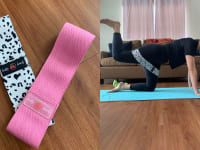How exercising sideways can move your fitness forward
Build better strength, balance, and agility with lateral training.
Products are chosen independently by our editors. Purchases made through our links may earn us a commission.
Whether your go-to workout is a spin class, a home HIIT session, or strength training at the gym, many exercises have you moving forward and backward and up and down. But moving side to side—or laterally—is an equally important part of a well-rounded workout routine.
Lateral training helps develop strength, agility, and balance, and can reduce the risk of injury for athletes and novices alike. Here’s what you need to know about incorporating lateral training into your workout routine.
What is lateral training?
Moving your body side to side while exercising, like during banded walks or side lunges, is known as lateral training. Many exercises like squats, curls, and forward lunges move in the sagittal plane, which means you’re moving forward and backward or up and down. Side-to-side movements, however, engage your frontal plane, allowing you to strengthen your smaller but important stabilizing muscles.
“By implementing lateral movements, you're isolating one side and the small muscles and tendons in the area at one time, allowing them to adapt, grow, and strengthen,” says Tami Smith, an ACE-certified personal trainer.
Lateral training introduces more variety into your workout, too, which is always a good thing, no matter your preferred method.
What is lateral training good for?
Because lateral movements challenge the muscles that typically work as stabilizers during other workouts or going about your daily tasks, lateral training can help you gain overall strength and balance. And it’s especially important if you’re an athlete who needs to stay agile on the court or field, as lateral training conditions you to quickly move side to side with ease.
Though lateral movements may not be the focus in your workout regimen, you can see why they might be important in your day-to-day. When you quickly side-step while walking down the sidewalk to get around others or catch yourself if you trip or stumble, having trained your body in the frontal plane can help prevent injury.
Who can benefit from lateral training?
The short answer: Everyone.
“It's very important to make sure you're training across all planes of motion to create a well-balanced, strong body that can handle various movements and sudden changes without the risk of injury,” Smith says.
That means whether you’re a regular at the gym or your exercise of choice is a brisk walk, you can benefit from lateral training. And it's especially important if you're a regular runner or cyclist, where your primary exercise moves your body almost exclusively forward and back. Without making an effort to strengthen the stabilizers in the hips, you can end up at risk for knee or ankle injury.
How can I start lateral training?
If you get your fitness routine from a workout app, like our favorite Nike Training Club, you may already be doing some lateral training, as it’s typical for bodyweight workouts to include exercises in this movement pattern—just take note of the exercises that have you moving side to side.
But if not, you can start lateral training at home, no equipment required. Smith recommends incorporating exercises like side lunges, banded walks, and lateral shoulder raises into your routine, starting with just your own body weight as resistance.
When you’re ready to level up, you can add resistance bands. For some basic rubber mini loops, try the Fit Simplify bands from Amazon. This set has 4.5 stars with more than 104,000 reviews, and reviewers say it’s a quality option. You can also try cloth resistance bands if you find rubber bands bunch or twist while you use them. The Walito band set is a highly rated option on Amazon with 4.7 stars and more than 18,600 reviews. Reviewers say these bands are durable and comfortable to exercise with and never bunch or slip.
If you find you love lateral training and want to make it even more challenging, consider a slide board—a smooth-surfaced platform on which you glide side to side on one foot then the other, not unlike a speed skater on the ice. The Brrrn board is a popular option that you can purchase with a subscription for access to Brrrn’s workout classes. Brrrn’s classes utilize the board and range from cardio to bootcamp to core training. The Brrrn board has a 4.7-star rating on Amazon and reviewers say they have a blast training with the board and Brrrn’s classes make it easy to get a great workout in.


